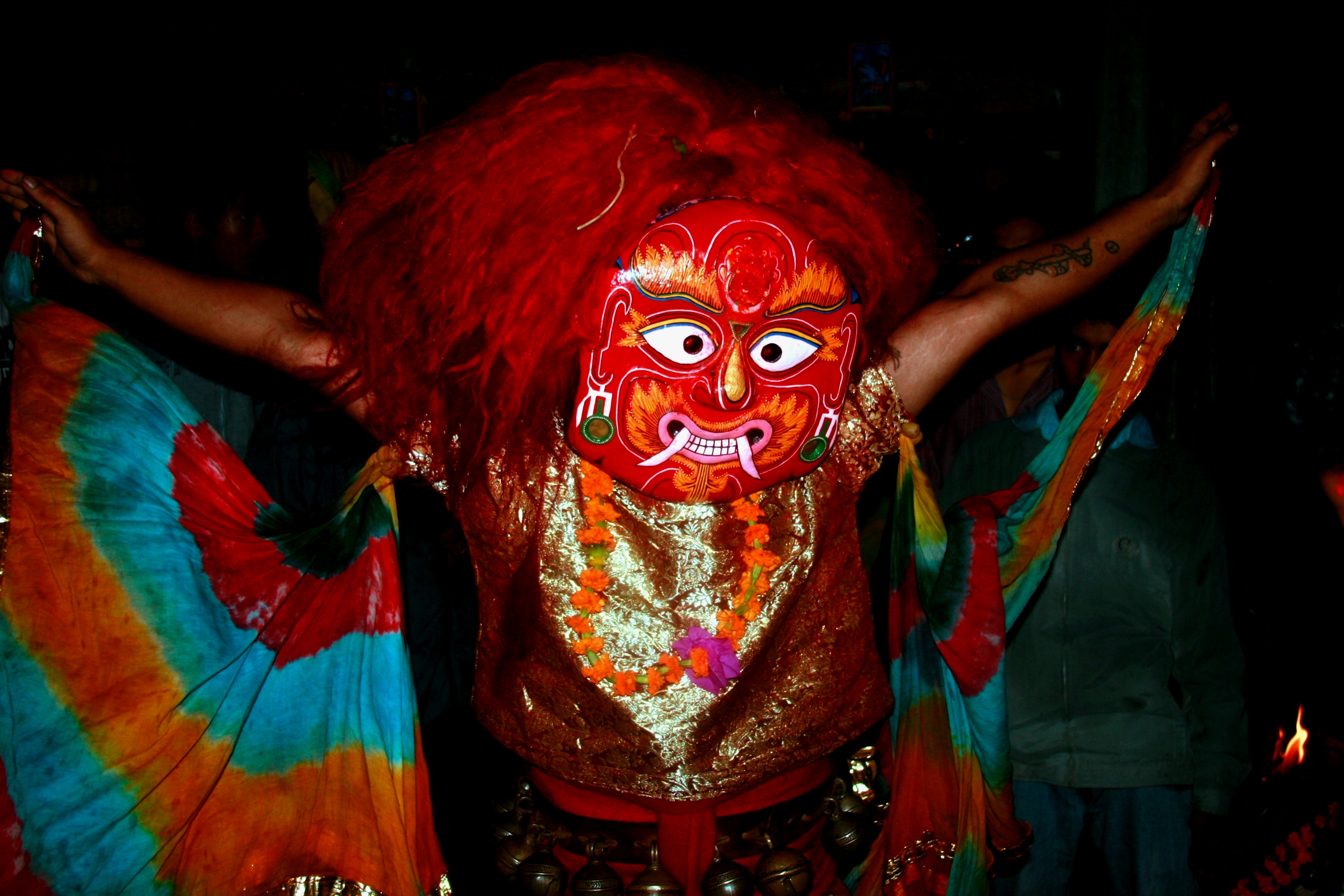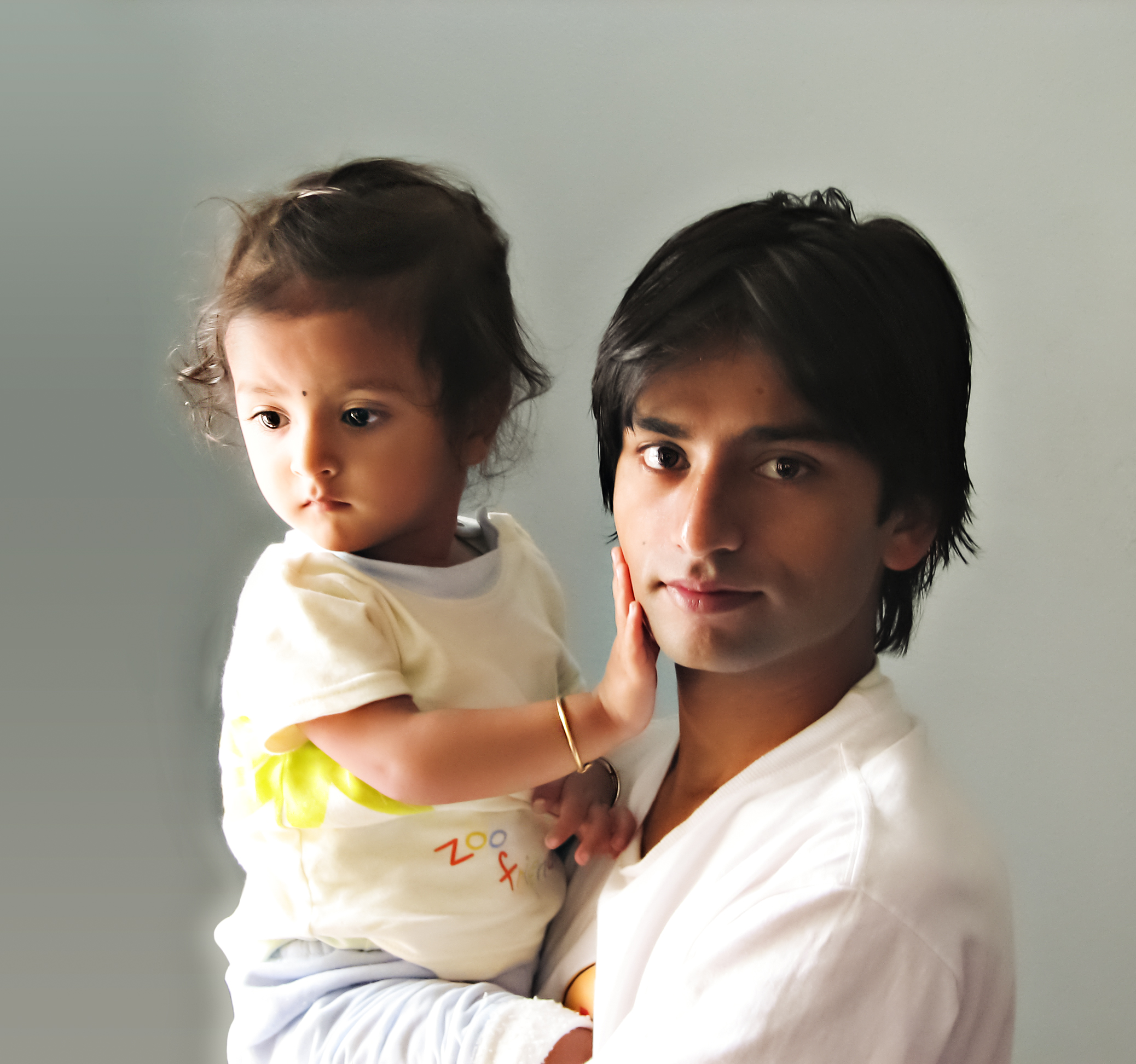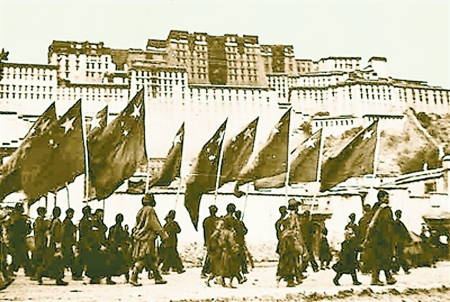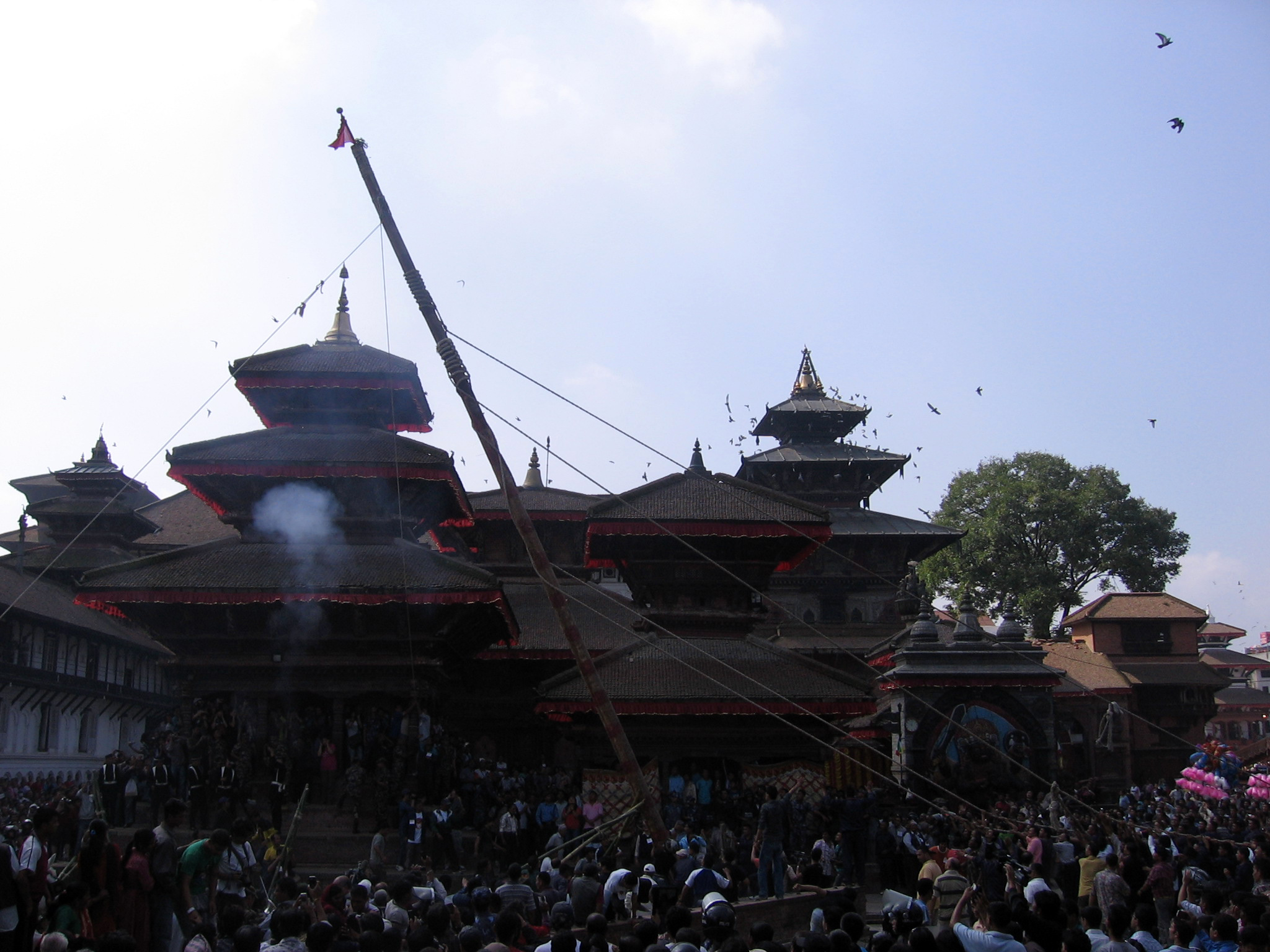|
Ranjitkar
Ranjitkar (रञ्जितकार a.k.a. Chhipaa or Ranjit) is one of the castes of Newar. The Newari caste system is divided according to profession. The Ranjitkar caste is concerned with the dyeing of clothes as well as other color related activities. The word "Ranjitkar" comes from Sanskrit origins crudely meaning "people concerned with colors" whereas the word "Chhipaa" is a Nepal Bhasa compound word which can be roughly translated as "color and allow to dry". History There are very few written historic documents on Ranjitkars. However, judging by the extravagant clothing that are seen in the sculptures, one can speculate that Ranjitkars or some other people were present in the Nepal during the Licchavi era by latest. The first mention of Ranjitkars in written history might have been during the declaration of the division of castes by Jayasthiti Malla. Race Ethnically, Ranjitkars like other Newar communities are of diverse origin including but not limited to various ... [...More Info...] [...Related Items...] OR: [Wikipedia] [Google] [Baidu] |
Majipa Lakhey
Majipa Lakhey (Nepal Bhasa: मजिपा लाखे, ) is a special lakhey in Nepalese folklore. He is also known as the Peaceful Bhairava (शान्त भैरव). The dance of this Lakhey takes place only in the week of the full moon of the month of Yenlaa of the Nepal Sambat calendar. He is considered to be the protector of the children. Etymology The Newari word ''Majipa'' is derived from Sanskrit "Manjupattan" "Manjusri city". Lākhe is the term used to denote carnivorous demons. Majipa Lakhey literally means the "carnivorous demon of Majipa". Mythology According to stories passed down through generations, majipa lakhey is supposed to have fallen in love with a girl from Majipa. So, the demon takes a form of a human and enters the city to see his beloved. Upon knowing the fact that the person is a Lakhey, the people capture the lakhey and present him to the king. The king makes a proposal to the demon that he will grant him a place in the city if he vows to p ... [...More Info...] [...Related Items...] OR: [Wikipedia] [Google] [Baidu] |
Caste System In Nepal
The Nepalese caste system is the traditional system of social stratification of Nepal. The Nepalese caste system broadly borrows the classical Hindu ''Chaturvarnashram'' model, consisting of four broad social classes or varna: Brahmin, Kshatriya, Vaishya, Sudra. The caste system defines social classes by a number of hierarchical endogamous groups often termed ''jaat''. This custom was traditionally only prevalent in the three Indo Aryan societies of the Khas, Madhesi, and Newars. However, since the unification of Nepal in the 18th century, Nepal's various non-Hindu ethnic nationalities and tribes, previously called "Matwalis" (alcohol-drinkers) and now termed as "Adivasi/Janajati" (indigenous/nationalities), have been incorporated within the caste hierarchy to varying degrees of success. Despite the forceful integration by the state into the pan-Hindu social structure, the traditionally non-Hindu groups and tribes do not necessarily adhere to the customs and practices of the ... [...More Info...] [...Related Items...] OR: [Wikipedia] [Google] [Baidu] |
Dhyan Govinda Ranjit
Dhyan Govinda Ranjit a.k.a. Dhyan Govinda Ranjitkar ( Nepali/Nepal Bhasa: ध्यान गोबिन्द रञ्जित) is a Nepalese politician and a leader of Nepali Congress. He is a member of Nepalese constituent assembly/Nepalese Parliament. Ranjit has twice been elected to the Nepalese Constituent Assembly from Kathmandu constituency on two consecutive elections. He is an elected member of Nepali Congress parliamentary party working committee (Nepali: संसदीय दलको कार्यसमिति) representing Province-3 (Nepali: Pradesh-3). He was a representative of Nepali Congress in work editing committee (Nepali:कार्य व्यवस्था परामर्श समिति) . He is the Past President of Kathmandu District Committee of Nepali Congress. Ranjit has been active in Nepalese politics since the "civil disobidience movement" (''bhadra awagya andolan'') in 1954 (2014 ''Bikram Sambat''). He was amongst the first group ... [...More Info...] [...Related Items...] OR: [Wikipedia] [Google] [Baidu] |
Newar
Newar (; , endonym: Newa; , Pracalit script: ), or Nepami, are primarily inhabitants in Kathmandu Valley of Nepal and its surrounding areas, and the creators of its historic heritage and civilisation. Page 15. Newars are a distinct linguistic and cultural group, primarily Indo-Aryan and Tibeto-Burman ethnicities, who share a common language, Nepal Bhasa, and predominantly practice Newar Hinduism and Newar Buddhism. Newars have developed a division of labour and a sophisticated urban civilisation not seen elsewhere in the Himalayan foothills. Newars have continued their age-old traditions and practices and pride themselves as the true custodians of the religion, culture and civilisation of Nepal. Newars are known for their contributions to culture, art and literature, trade, agriculture and cuisine. Today, they consistently rank as the most economically and socially advanced community in Nepal, according to the annual Human Development Index published by UNDP. Newars are ... [...More Info...] [...Related Items...] OR: [Wikipedia] [Google] [Baidu] |
Nepal
Nepal, officially the Federal Democratic Republic of Nepal, is a landlocked country in South Asia. It is mainly situated in the Himalayas, but also includes parts of the Indo-Gangetic Plain. It borders the Tibet Autonomous Region of China China–Nepal border, to the north, and India India–Nepal border, to the south, east, and west, while it is narrowly separated from Bangladesh by the Siliguri Corridor, and from Bhutan by the States and union territories of India, Indian state of Sikkim. Nepal has a Geography of Nepal, diverse geography, including Terai, fertile plains, subalpine forested hills, and eight of the world's ten List of highest mountains#List, tallest mountains, including Mount Everest, the highest point on Earth. Kathmandu is the nation's capital and List of cities in Nepal, its largest city. Nepal is a multi-ethnic, multi-lingual, multi-religious, and multi-cultural state, with Nepali language, Nepali as the official language. The name "Nepal" is first record ... [...More Info...] [...Related Items...] OR: [Wikipedia] [Google] [Baidu] |
Nepali Language
Nepali (; , ), or ''Gorkhali'' is an Indo-Aryan languages, Indo-Aryan language native to the Himalayas region of South Asia. It is the official and most widely spoken Languages of Nepal, language of Nepal, where it also serves as a ''lingua franca''. Nepali has Languages with official status in India, official status in the Indian state of Sikkim and in the Gorkhaland Territorial Administration of West Bengal. It is spoken by about a quarter of Bhutan's population. Nepali also has a significant number of speakers in the Indian states of Arunachal Pradesh, Assam, Himachal Pradesh, Manipur, Meghalaya, Mizoram and Uttarakhand. In Myanmar it is spoken by the Burmese Gurkhas. The Nepali diaspora in the Middle East, Brunei, Australia and worldwide also use the language. Nepali is spoken by approximately 19 million native speakers and another 14 million as a second language. Nepali is commonly classified within the Eastern Pahari group of the Northern Indo-Aryan languages, Northern zo ... [...More Info...] [...Related Items...] OR: [Wikipedia] [Google] [Baidu] |
Annexation Of Tibet By The People's Republic Of China
Tibet came under the control of China, People's Republic of China (PRC) after the Ganden Phodrang, Government of Tibet signed the Seventeen Point Agreement which the 14th Dalai Lama ratified on 24 October 1951, but later repudiated on the grounds that he had rendered his approval for the agreement under duress. This occurred after attempts by the Tibetan Government to gain diplomatic recognition, international recognition, efforts to modernize its Tibetan Army, military, negotiations between the Government of Tibet and the PRC, and Battle of Chamdo, a military conflict in the Chamdo area of western Kham in October 1950. The series of events came to be called the "Peaceful Liberation of Tibet" agreed by the government of China, Chinese government, the plenipotentiary of the Tibetan Local Government and the Dalai Lama despite several thousand casualties being reported by Chinese generals throughout the invasion, and the "Chinese invasion of Tibet" by the Central Tibetan Administr ... [...More Info...] [...Related Items...] OR: [Wikipedia] [Google] [Baidu] |
Gautama Buddha
Siddhartha Gautama, most commonly referred to as the Buddha (),* * * was a śramaṇa, wandering ascetic and religious teacher who lived in South Asia during the 6th or 5th century BCE and founded Buddhism. According to Buddhist legends, he was born in Lumbini, in what is now Nepal, to royal parents of the Shakya clan, but Great Renunciation, renounced his Householder (Buddhism), home life to live as a wandering ascetic. After leading a life of mendicancy, asceticism, and meditation, he attained Nirvana (Buddhism), nirvana at Bodh Gaya, Bodh Gayā in what is now India. The Buddha then wandered through the lower Indo-Gangetic Plain, teaching and building a Sangha, monastic order. Buddhist tradition holds he died in Kushinagar and reached ''parinirvana'' ("final release from conditioned existence"). According to Buddhist tradition, the Buddha taught a Middle Way between sensual indulgence and severe asceticism, leading to Vimutti, freedom from Avidyā (Buddhism), ignora ... [...More Info...] [...Related Items...] OR: [Wikipedia] [Google] [Baidu] |
Nirvana
Nirvana, in the Indian religions (Jainism, Hinduism, Buddhism, and Sikhism), is the concept of an individual's passions being extinguished as the ultimate state of salvation, release, or liberation from suffering ('' duḥkha'') and from the cycle of birth and rebirth ('' saṃsāra''). In Indian religions, nirvana is synonymous with ''moksha'' and ''mukti''. All Indian religions assert it to be a state of perfect quietude, freedom, and highest happiness; liberation from attachment and worldly suffering; and the ending of ''samsara'', the cycle of existence.Gavin Flood, ''Nirvana''. In: John Bowker (ed.), '' Oxford Dictionary of World Religions'' However, non-Buddhist and Buddhist traditions describe these terms for liberation differently. In Hindu philosophy, it is the union of or the realization of the identity of Atman with Brahman, depending on the Hindu tradition. In Jainism, nirvana is also the soteriological goal, representing the release of a soul from karmic bondage ... [...More Info...] [...Related Items...] OR: [Wikipedia] [Google] [Baidu] |
Yenya
Indra Jātrā, also known as Yenyā Punhi is the biggest religious street festival in Kathmandu, Nepal. "Ye" means the old Newari name for "Kathmandu", "Ya" means “Celebration”, and "Puhni" means full moon so together means the birthday of the old city of Kathmandu. The celebrations consist of two events, Indra Jātrā and Kumāri Jātrā. Indra Jātrā is marked by masked dances of deities and demons, displays of sacred images, and tableaus in honor of the deity Indra, the king of heaven. Kumāri Jātrā is the chariot procession of the living goddess Kumari. Family members deceased in the past year are also remembered during the festival. The main venue of the festival is Kathmandu Durbar Square. The celebrations last for eight days from the 12th day of the bright fortnight to the 4th day of the dark fortnight of Yanlā (ञला), the eleventh month in the lunar Nepal Era calendar. Indra Jatra was started by King Gunakamadeva- (गुणकामदेव) to comme ... [...More Info...] [...Related Items...] OR: [Wikipedia] [Google] [Baidu] |
Jatra (Bengal)
Jatra () is a popular folk-theatre from Bengali theatre and Odia theatre, spread throughout most of Eastern areas of the Indian subcontinent, including Bangladesh and Indian states of West Bengal, Assam, Odisha and Tripura As of 2005, there were some 55 troupes based in Calcutta's old Jatra district, Chitpur Road and all together, is a $21m-a-year industry, performed on nearly 4,000 stages in West Bengal alone, where in 2001, over 300 companies employed over 20,000 people, more than the local film industry and urban theatre. The word means journey or going. The origin of intrinsically a musical theatre form, is traditionally credited to the rise of Sri Chaitanya's Bhakti movement, wherein Chaitanya himself played Rukmini in the performance of ''Rukmini Haran'' ("The abduction of the Charming Rukmini") from Krishna's life story, a first definite presentation of this theatrical spectacle. The performance, which lasted through the night in 1507 AD., has been described in '' ... [...More Info...] [...Related Items...] OR: [Wikipedia] [Google] [Baidu] |
Guthi
Guthi or Gosthi; Newar language, Newar: , romanized: ''guthi''; etymologically from is a social system of the Newar community in Nepal. With land trusts, Guthis support the socio-economic status of their communities.Title:नेपाली संस्कृतिका छटाहरु, Author:Mangala Devi Singh, Publisher:Dr.Meeta Singh The land held by Guthis is used for various projects and to generate revenue. The system began around the 5th century B.C., and most Guthis are now either defunct or a vestigial representation of their former role. In 2019, the Guthi bill—which proposed nationalizing all Guthis—was withdrawn following protests by Newars in Kathmandu Valley. Organizational structure Guthi is a social organization prevalent among the Newar people, Newars. The system is integrated into the social structure of communities. It consists of a ''Thakali'', or the eldest person of the Guṭhī. The consent of the ''thakali'' is essential for formulating most of ... [...More Info...] [...Related Items...] OR: [Wikipedia] [Google] [Baidu] |






